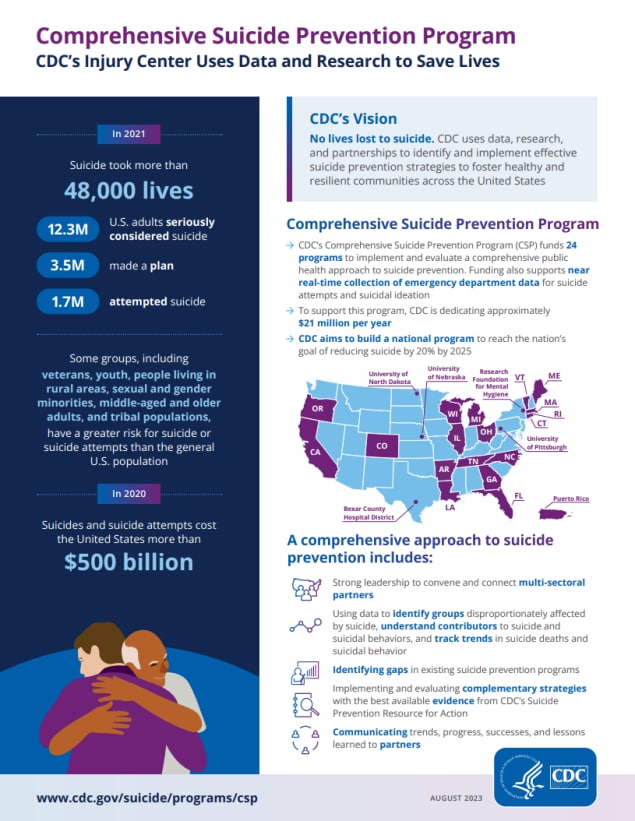Comprehensive Suicide Prevention

CDC’s Comprehensive Suicide Prevention Program (CSP) funds 24 programs to implement and evaluate a comprehensive public health approach to suicide prevention, with a special focus on populations that are disproportionately affected by suicide.
A comprehensive approach to suicide prevention includes:
- Strong leadership to convene and connect multi-sectoral partnerships
- Using data to:
- identify disproportionately affected populations with increased risk of suicide
- understand contributors to suicide and suicidal behaviors
- track trends in suicide deaths and suicidal behavior
- Identifying and assessing gaps in existing programs in the jurisdiction
- Implementing and evaluating complementary strategies with the best available evidence from the Suicide Prevention Resource for Action
- Developing, implementing, and evaluating a communication and dissemination plan to communicate trends, progress, successes, and lessons learned to partners
A key goal of this funding is a 10% reduction in suicide and suicide attempts among populations that are disproportionately affected by suicide. These populations include veterans, tribal populations, rural communities, LGBTQ, youth/young adults, and others.
Through CSP cooperative agreements, CDC aims to build a national program to reach the nation’s goal of reducing suicide by 20% by 2025.
To support this program, CDC is dedicating approximately $21 million per year.
*Enhancing CSP with Syndromic Surveillance

20 CSP programs also use funds to support emergency department syndromic surveillance of nonfatal suicide-related outcomes (for example, suicide attempts and suicidal ideation). Collecting these near real-time data can help states rapidly track and respond to changing patterns in suicidal behavior.
This surveillance work builds upon CDC’s previously funded Emergency Department Surveillance of Nonfatal Suicide-Related Outcomes program.
September 2023:
- Arkansas Department of Health*
- Bexar County Hospital District (Texas)*
- Illinois Department of Health*
- Ohio Department of Health*
- Puerto Rico Department of Health*
- Rhode Island Department of Health*
- University of Nebraska*
September 2022:
- Florida Department of Health*
- Georgia Department of Public Health*
- Research Foundation for Mental Hygiene (New York)*
- Oregon Health Authority/Public Health Division*
- University of North Dakota*
- Wisconsin Department of Health Services*
September 2021:
- Louisiana Department of Health*
- Maine Center for Disease Control and Prevention*
September 2020:
- California Department of Public Health*
- Colorado Department of Public Health and Environment
- Connecticut Department of Public Health
- Massachusetts Department of Public Health
- Michigan Department of Health and Human Services*
- North Carolina Department of Health and Human Services*
- Tennessee Department of Health*
- University of Pittsburgh
- Vermont Department of Health*
Find out more about what CDC is doing to prevent suicide. Visit CDC’s Suicide Prevention webpage.
